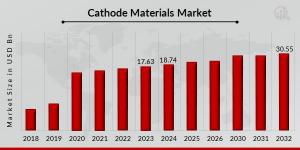Cathode Materials Market Expanding at a Healthy 6.30% CAGR | Industry Analysis by Top Leading Player & Forecast by 2032
The cathode materials Market size was valued at USD 17.63 Billion in 2023 and is projected to reach USD 30.55 Billion by 2032, at a CAGR of 6.30%
CA, UNITED STATES, April 29, 2025 /EINPresswire.com/ -- As the world races toward a cleaner and more electrified future, the spotlight is firmly on energy storage technologies, most notably lithium-ion batteries. At the heart of these batteries lies a critical component that often goes unnoticed but plays a pivotal role in determining performance, cost, and environmental impact: the cathode material.Cathode Materials Market size was valued at USD 17.63 billion in 2023. The cathode material industry is projected to grow from USD 18.74 billion in 2024 to USD 30.55 Billion by 2032, exhibiting a compound annual growth rate (CAGR) of 6.30% during the forecast period (2024 - 2032).
What Are Cathode Materials?
In simple terms, cathode materials are the positive electrode materials used in batteries. During a battery’s discharge cycle, lithium ions move from the anode to the cathode, releasing energy in the process. The composition and structure of the cathode material dictate how many lithium ions it can hold and release—directly influencing the battery’s energy density, voltage, and longevity.
Cathode materials are primarily used in lithium-ion batteries found in electric vehicles (EVs), smartphones, laptops, power tools, and increasingly in renewable energy storage systems. Given their wide-ranging applications, cathode materials are considered one of the most valuable components in battery chemistry.
Request for a Sample of the Report: https://www.marketresearchfuture.com/sample_request/6528
Common Types of Cathode Materials
The most commonly used cathode materials fall into several categories, each with its own set of advantages and trade-offs:
1. Lithium Cobalt Oxide (LCO) – LiCoO₂
Use Case: Smartphones, laptops, digital cameras
Strengths: High energy density and relatively simple manufacturing process
Weaknesses: High cost and thermal instability LCO was among the earliest commercial cathode materials and remains popular in consumer electronics due to its compact size and efficiency.
2. Lithium Iron Phosphate (LFP) – LiFePO₄
Use Case: Electric vehicles, energy storage systems
Strengths: Excellent thermal stability, long cycle life, low cost, and safety
Weaknesses: Lower energy density compared to other materials LFP is rapidly gaining ground, especially in the EV market, thanks to its safety profile and cost-effectiveness, particularly in markets like China.
3. Lithium Nickel Manganese Cobalt Oxide (NMC) – LiNiMnCoO₂
Use Case: EVs, power tools
Strengths: Balanced energy density, cost, and thermal stability
Weaknesses: Reliant on cobalt, which is expensive and often sourced under challenging ethical conditions NMC is one of the most versatile and widely adopted cathode materials, with various compositions like NMC 811, 622, and 111 depending on the proportion of nickel, manganese, and cobalt.
4. Lithium Nickel Cobalt Aluminum Oxide (NCA) – LiNiCoAlO₂
Use Case: High-performance EVs, such as Tesla vehicles
Strengths: High energy density and power output
Weaknesses: Safety concerns and high cost NCA offers one of the highest energy densities available, making it ideal for long-range electric vehicles.
5. Lithium Manganese Oxide (LMO) – LiMn₂O₄
Use Case: Medical devices, power tools, and early-model EVs
Strengths: High thermal stability, safe, and cost-effective
Weaknesses: Shorter cycle life and lower capacity While not as popular as others today, LMO remains relevant in niche applications.
Buy Now: https://www.marketresearchfuture.com/checkout?currency=one_user-USD&report_id=6528
Trends Shaping the Future of Cathode Materials
As battery technology continues to evolve, several key trends are shaping the future landscape of cathode materials:
1. Nickel-Rich Chemistries
Manufacturers are increasingly shifting toward nickel-rich compositions (like NMC 811) to improve energy density and reduce reliance on cobalt, which is both expensive and associated with human rights concerns.
2. Cobalt Reduction and Elimination
Due to ethical sourcing challenges and high costs, there's a global push to develop low- or zero-cobalt cathode chemistries. Research into cobalt-free cathodes such as LFP and lithium manganese-rich composites is gaining momentum.
3. Solid-State Batteries
Next-generation solid-state batteries aim to replace liquid electrolytes with solid materials, potentially revolutionizing cathode materials. These batteries may require new cathode designs that are stable with solid electrolytes.
4. Recycling and Sustainability
With environmental regulations tightening and EV adoption accelerating, the recycling of cathode materials is becoming critical. Companies are investing in closed-loop systems to recover lithium, nickel, cobalt, and manganese from spent batteries.
5. Localized Supply Chains
To reduce dependence on global supply chains, especially for critical minerals like cobalt and nickel, countries are exploring domestic production and alternative materials that can be sourced locally.
Complete Report: https://www.marketresearchfuture.com/reports/cathode-materials-market-6528
Challenges Facing the Cathode Material Market
Despite the exciting progress, several challenges remain:
Raw material shortages: As demand for EVs grows, the supply of lithium, cobalt, and nickel remains constrained.
Cost pressures: With raw material prices fluctuating, manufacturers face pressure to reduce battery costs without sacrificing performance.
Technological limitations: Improvements in energy density and cycle life are still constrained by the limits of current cathode chemistry.
Safety: Thermal runaway, particularly in nickel-rich chemistries, remains a concern that needs to be addressed with better engineering and battery management systems.
MRFR recognizes the following Cathode Materials Companies - Umicore (Belgium),3M (US),Mitsubishi Chemical Holdings (Japan),POSCO (South Korea),Johnson Matthey (UK),Hitachi Chemical Co., Ltd. (Japan),Kureha Corporation (Japan),Sumitomo Corporation (Japan),Todakogyo Corp (Japan),Mitsui Mining & Smelting (Japan),NEI Corporation (US),Targray Technology International Inc. (Canada)
Cathode materials are the cornerstone of lithium-ion battery performance, dictating not just energy capacity but also cost, safety, and lifespan. As the demand for electric mobility and renewable energy soars, the pressure is on researchers and manufacturers to innovate and scale up sustainable, high-performance cathode technologies.
Browse Related Reports:
Aerospace Materials Market - https://www.marketresearchfuture.com/reports/aerospace-materials-market-8428
Smart Materials Market - https://www.marketresearchfuture.com/reports/smart-materials-market-5333
Structural Core Materials Market - https://www.marketresearchfuture.com/reports/structural-core-materials-market-6213
Gasket & Seal Materials Market - https://www.marketresearchfuture.com/reports/gasket-seal-materials-market-10105
Electronic Materials Market - https://www.marketresearchfuture.com/reports/electronic-materials-market-22112
Green Building Materials Market - https://www.marketresearchfuture.com/reports/green-building-materials-market-1865
Market Research Future
Market Research Future
+ +1 855-661-4441
email us here
Visit us on social media:
Facebook
X
LinkedIn
Legal Disclaimer:
EIN Presswire provides this news content "as is" without warranty of any kind. We do not accept any responsibility or liability for the accuracy, content, images, videos, licenses, completeness, legality, or reliability of the information contained in this article. If you have any complaints or copyright issues related to this article, kindly contact the author above.
HIP Video Promo Presents: Major Spark premieres new music video "The Other Side" on Music-News.com
HIP Video Promo Presents: Captains Of Entropy premiere brand new music video 'The Flea' on Music-News.com
SLEEP IN HEAVENLY PEACE ANNOUNCES 11 NEW CHAPTERS
Kalendarium
Więcej ważnych informacji
 Jedynka Newserii
Jedynka Newserii

 Jedynka Newserii
Jedynka Newserii

Bankowość

Coraz mniej kredytów bankowych płynie do polskiej gospodarki. Przed sektorem duże wyzwania związane z finansowaniem strategicznych projektów
Polskie przedsiębiorstwa w coraz mniejszym stopniu finansują się kredytem bankowym, zwłaszcza w porównaniu z rosnącym PKB. Powoduje to wysoką nadpłynność sektora bankowego. Deregulacja mogłaby pomóc w skróceniu drogi firm do finansowania bankowego, zwłaszcza że Polskę czekają ogromne wydatki na transformację energetyczną i obronność. Sektor ma bardzo dobre wyniki finansowe, co powoduje, że politycy patrzą w stronę jego zysków. Ryzyko prawne, jakim wciąż są kredyty frankowe, pociąga za sobą brak zainteresowania ze strony zagranicznych inwestorów.
Firma
Bezrobocie może zacząć rosnąć. Ochłodzenie odczuwane szczególnie w branży budowlanej i automotive

W Polsce od kilku lat stopa bezrobocia utrzymuje się poniżej 6 proc., a według metodologii unijnej jest o połowę niższa i jedna z najniższych w Unii. Pracownicy przywykli już, że sytuacja na rynku pracy jest dla nich korzystna. Jednak zaczynają się pojawiać pierwsze niepokojące sygnały zwiastujące możliwą zmianę trendu. Część branż ucierpiała np. z powodu spowolnienia w Niemczech, inne rozważają wybór innej niż Polska lokalizacji ze względu na wysokie koszty pracy czy energii. Na razie ogromnym wyzwaniem pozostaje aktywizacja osób biernych zawodowo.
Ochrona środowiska
Rozwój sztucznej inteligencji drastycznie zwiększa zapotrzebowanie na energię. Rozwiązaniem są zrównoważone centra danych

Centra danych to jeden z dynamicznie rozwijających się, ale przy tym energochłonnych sektorów gospodarki. Prognozy PMR wskazują, że do 2030 roku operatorzy w Polsce będą dysponować centrami danych o mocy przekraczającej 500 MW, co oznacza, że wzrośnie ona ponad trzykrotnie względem 2024 roku. Przyspieszona cyfryzacja i dynamiczny rozwój sztucznej inteligencji sprawiają, że w ciągu kilku następnych lat zużycie energii elektrycznej w centrach danych tylko w Europie wzrośnie o 66 proc. Dlatego coraz więcej firm sięga po zrównoważone rozwiązania i energię pochodzącą ze źródeł odnawialnych.
Partner serwisu
Szkolenia

Akademia Newserii
Akademia Newserii to projekt, w ramach którego najlepsi polscy dziennikarze biznesowi, giełdowi oraz lifestylowi, a także szkoleniowcy z wieloletnim doświadczeniem dzielą się swoją wiedzą nt. pracy z mediami.



![Europejskie miasta planują wzrost inwestycji w infrastrukturę społeczną. Wydatki na niskoemisyjny transport wciąż są niewystarczające [DEPESZA]](https://www.newseria.pl/files/1097841585/panel-dotacje-foto,w_85,_small.jpg)





.gif)

 |
| |
| |
|